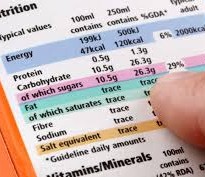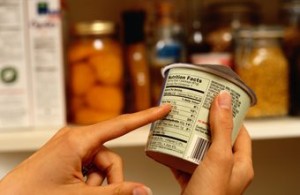Ensuring Food Labelling Compliance With UK & EU Law
Posted on 27/10/2017 in Company News, by Jon

Whether you’re manufacturing food or beverages, the labels on your products serve a vital role in providing essential information to consumers, ensuring safety, and complying with food labelling laws. From ingredients and nutritional information to allergen warnings, food labels must meet strict legal requirements.
Is your food product’s label compliant with the latest regulations?
Use our food labelling checklist below to make sure your food and drink labels meet all legal requirements.
Food Labelling Checklist:
To stay compliant with UK and EU laws, always ensure your labels:
- Are clear and easy to read
- Are permanent and durable
- Contain easy-to-understand language
- Display information in a visible and accessible format
- Are not misleading in any way
In addition, the following information is required by law on your food labels:
1. Essential Label Information
-
Name of the Food: The product must be clearly identified. For example, “Tomato Soup” or “Apple Juice.”
-
Best Before or Use By Date:
- Use By Date: For perishable foods that are likely to pose a safety risk (e.g., dairy, meat).
- Best Before Date: For foods that are safe to consume after the date but may lose quality (e.g., dry goods, frozen foods).
- Where to Find It: If the date is not printed directly on the packaging, include instructions on where to locate it (e.g., on a separate label or seal).
-
Allergen Information: Any allergens present in the product must be highlighted. The top 14 allergens must be clearly marked (e.g., nuts, milk, gluten).
-
Net Quantity:
- Must be shown in grams, kilograms, or litres for packaged food over 5g or 5ml.
- For products in liquid, show the drained net weight (e.g., a tin of peas).
- Alcoholic drinks should include the alcoholic strength (ABV).
-
Ingredient List:
- Include all ingredients in descending order by weight. For example, a fruit juice label must list “apple juice concentrate, water, sugar.”
-
Manufacturer Information: The name and address of the manufacturer, packer, or seller should be clearly visible.
-
Country of Origin:
- Mandatory for certain items like meat (beef, lamb, chicken), fish, honey, olive oil, and wine.
- For food items, country of origin labeling must prevent consumer confusion. For example, a pizza label featuring the Leaning Tower of Pisa must not mislead customers if the pizza was made in the UK.
-
Lot Number or Use By Date: This is essential for traceability, especially in the case of a recall.
-
Storage Conditions: Instructions such as “keep refrigerated” or “store in a cool, dry place.”
-
Instructions for Use or Cooking: For products that need preparation (e.g., cooking instructions for frozen meals), these must be included clearly.
2. Additional Labeling Requirements
- Quantity Information:
- Display the net quantity (weight or volume) of the food in metric units (grams, kilograms, millilitres, etc.).
- Example: A pack of biscuits must show “Net Weight: 250g.”
- For multi-item packages (like bread rolls), you don’t need to show the quantity, as the number of items can be clearly seen.
3. Other Important Warnings and Statements
Certain food products may require specific warnings or statements, such as:
-
Alcohol Warning: If your product contains more than 1.2% alcohol, a health warning may be required (e.g., “Drink responsibly”).

-
GM Ingredients:
- If the product contains genetically modified (GM) ingredients, this must be declared, unless the GM content is accidental and under 0.9%.
-
Irradiated Food: Foods that have been irradiated (e.g., to extend shelf life) must be clearly labeled as such.
-
Packaging Atmosphere: If your food is packaged in a protective atmosphere (e.g., using a gas like nitrogen to preserve freshness), this must be stated.
4. Country of Origin Labelling
For certain food products, you must include the country of origin. These items include:
- Meats (beef, veal, lamb, mutton, pork, goat, poultry)
- Fish and Shellfish
- Honey
- Olive Oil
- Wine
- Fruit and Vegetables (if imported from outside the EU)
This is to ensure that consumers are not misled about the true origin of the food product.
5. Special Rules for Specific Foods
Certain types of food have additional or specific labelling requirements:
- Bottled Water: Must include source and mineral content.
- Bread and Flour: Requires labelling of the flour type and its country of origin.
- Cocoa and Chocolate Products: Must include the cocoa content percentage.
- Fish and Meat Products: Must show the species and the country of origin.
6. Using the ‘®’ Mark
The ‘®’ mark indicates that the product meets EU or UK regulations. It can also help you export your product to other European Economic Area (EEA) countries without needing to meet additional measurement and weight regulations specific to each country.
Conclusion: Stay Compliant and Protect Your Brand
Correct food labelling is not only essential for consumer safety but also for building trust and loyalty with your customers. Failure to comply with food labelling laws can result in fines, product recalls, and damage to your brand reputation.
For more information, or if you need assistance designing labels that comply with UK and EU food labelling laws, contact us today! With over 40 years of expertise in label making, we can ensure your food product labels meet all legal requirements while looking great.
Additional Tips for Compliant Food Labels:
-
Keep Updated on Laws: Food labelling laws are subject to change. Make sure you’re aware of any recent amendments to legislation, especially after Brexit.
-
Prioritize Legibility: Ensure that your label design is easy to read. Clear font choices, appropriate size, and contrasting colors will make a big difference.
-
Consider Customer Needs: When designing your labels, think about your customers. Are there other things they might need to know about the product (e.g., ethical sourcing, vegan certification, or environmental impact)?
By following this checklist, you’ll ensure your food and drink labels are legally compliant and informative for your customers.

